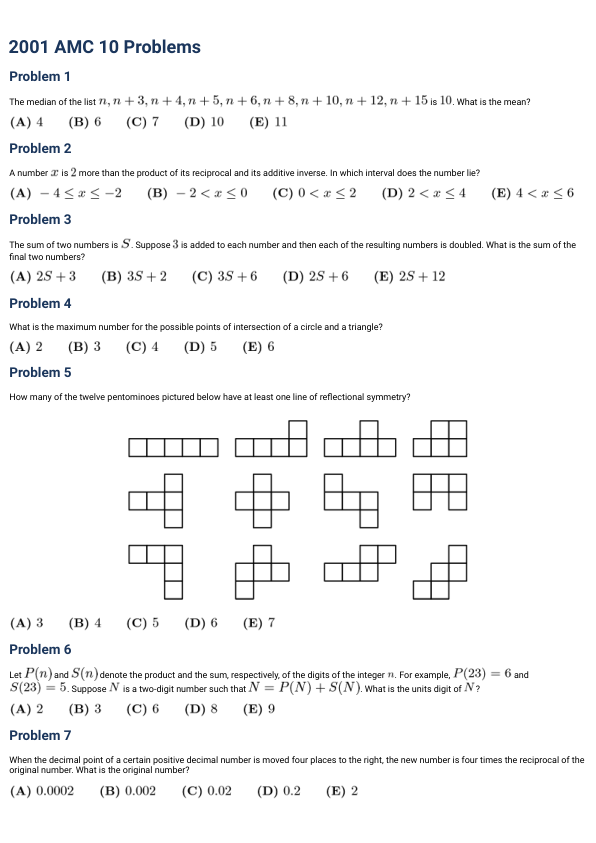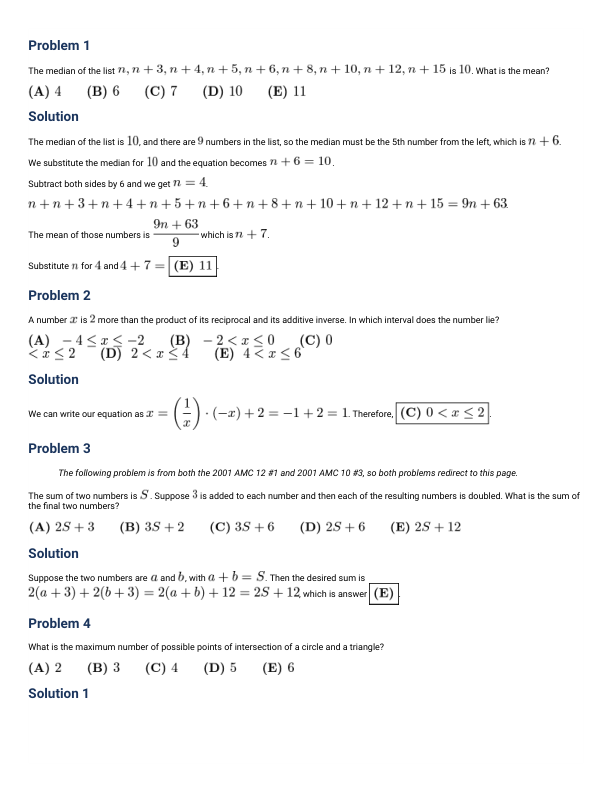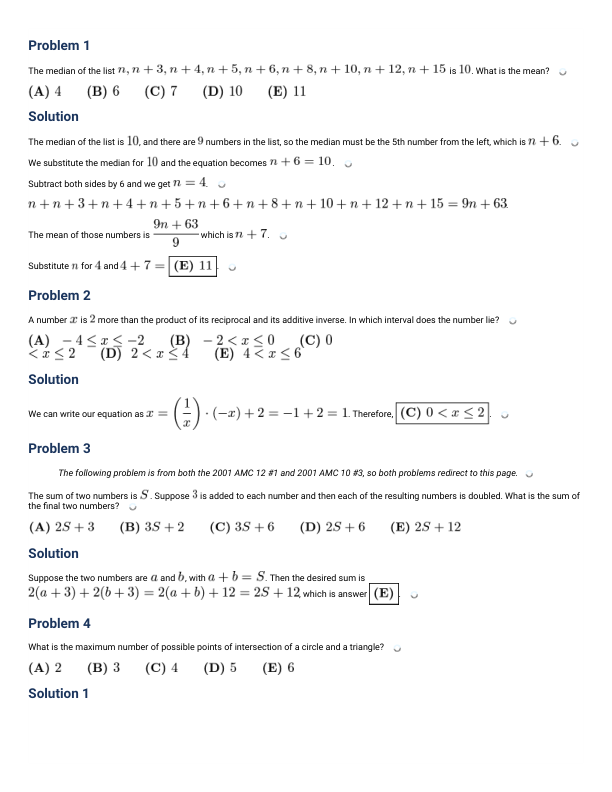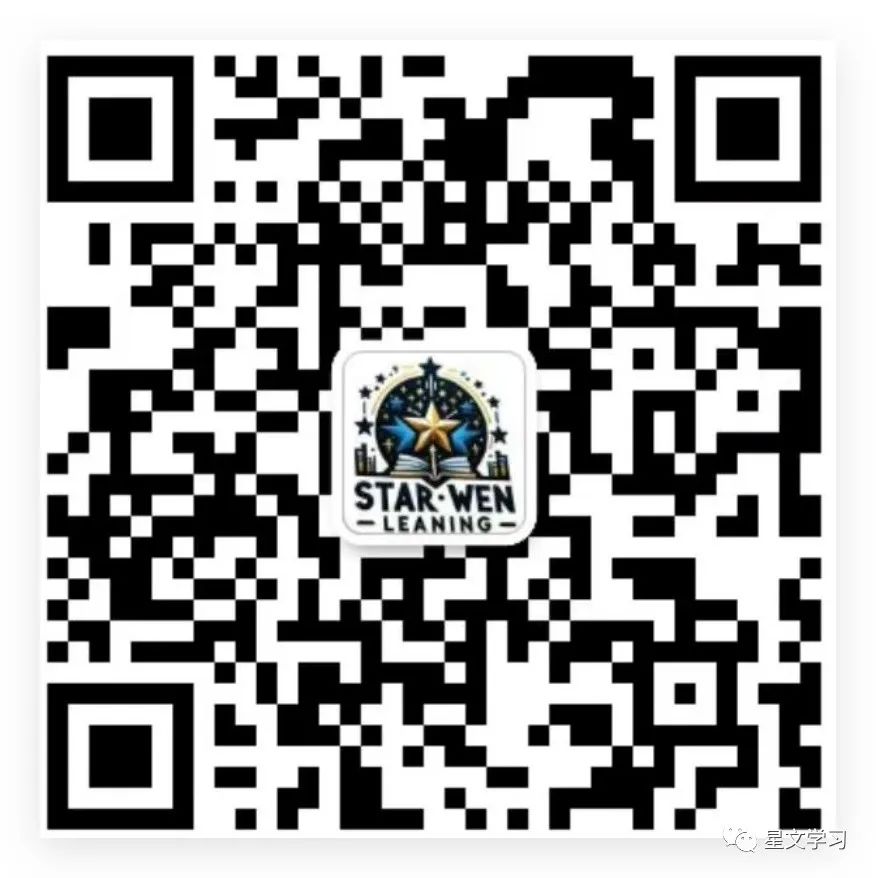2001 AMC amc10 真题 答案 详解
| 序号 | 文件列表 | 说明 | ||
|---|---|---|---|---|
| 1 | 2001-amc10-paper-eng.pdf | 4 页 | 183.94KB | 英文真题 |
| 2 | 2001-amc10-key.pdf | 1 页 | 9.92KB | 真题答案 |
| 3 | 2001-amc10-solution-eng.pdf | 22 页 | 1.02MB | 真题文字详解(英文) |
| 4 | 2001-amc10-solution-eng-zh.pdf | 22 页 | 1.14MB | 真题文字详解(中英双语) |
英文真题
2001 AMC 10 Problems
Problem 1
The median of the list ( n, n+3, n+4, n+5, n+6, n+8, n+10, n+12, n+15 ) is 10. What is the mean?
(A) 4 (B) 6 (C) 7 (D) 10 (E) 11
Problem 2
A number ( x ) is 2 more than the product of its reciprocal and its additive inverse. In which interval does the number lie?
(A) ( -4 \leq x \leq -2 ) (B) ( -2 < x \leq 0 ) (C) ( 0 < x \leq 2 ) (D) ( 2 < x \leq 4 ) (E) ( 4 < x \leq 6 )
Problem 3
The sum of two numbers is ( S ). Suppose 3 is added to each number and then each of the resulting numbers is doubled. What is the sum of the final two numbers?
(A) ( 2S + 3 ) (B) ( 3S + 2 ) (C) ( 3S + 6 ) (D) ( 2S + 6 ) (E) ( 2S + 12 )
Problem 4
What is the maximum number for the possible points of intersection of a circle and a triangle?
(A) 2 (B) 3 (C) 4 (D) 5 (E) 6
Problem 5
How many of the twelve pentominoes pictured below have at least one line of reflectional symmetry?
(A) 3 (B) 4 (C) 5 (D) 6 (E) 7
Problem 6
Let ( P(n) ) and ( S(n) ) denote the product and the sum, respectively, of the digits of the integer ( n ). For example, ( P(23) = 6 ) and ( S(23) = 5 ). Suppose ( N ) is a two-digit number such that ( N = P(N) + S(N) ). What is the units digit of ( N )?
(A) 2 (B) 3 (C) 6 (D) 8 (E) 9
Problem 7
When the decimal point of a certain positive decimal number is moved four places to the right, the new number is four times the reciprocal of the original number. What is the original number?
(A) 0.0002 (B) 0.002 (C) 0.02 (D) 0.2 (E) 2

真题文字详解(英文)
Problem 1 The median of the list n, n+3, n+4, n+5, n+6, n+8, n+10, n+12, n+15 is 10. What is the mean?
(A) 4 (B) 6 (C) 7 (D) 10 (E) 11
Solution
The median of the list is 10, and there are 9 numbers in the list, so the median must be the 5th number from the left, which is n + 6. We substitute the median for 10 and the equation becomes n + 6 = 10. Subtract both sides by 6 and we get n = 4. n + n + 3 + n + 4 + n + 5 + n + 6 + n + 8 + n + 10 + n + 12 + n + 15 = 9n + 63. The mean of those numbers is (\frac{9n + 63}{9}) which is n + 7. Substitute n for 4 and 4 + 7 = (E) 11.
Problem 2 A number x is 2 more than the product of its reciprocal and its additive inverse. In which interval does the number lie?
(A) -4 ≤ x ≤ -2 (B) -2 < x ≤ 0 (C) 0 < x ≤ 2 (D) 2 < x ≤ 4 (E) 4 < x ≤ 6
Solution
We can write our equation as (x = \left( \frac{1}{x} \right) \cdot (-x) + 2 = -1 + 2 = 1). Therefore, (C) 0 < x ≤ 2.
Problem 3 The following problem is from both the 2001 AMC 12 #1 and 2001 AMC 10 #3, so both problems redirect to this page. The sum of two numbers is S. Suppose 3 is added to each number and then each of the resulting numbers is doubled. What is the sum of the final two numbers?
(A) 2S + 3 (B) 3S + 2 (C) 3S + 6 (D) 2S + 6 (E) 2S + 12
Solution
Suppose the two numbers are a and b, with a + b = S. Then the desired sum is 2(a + 3) + 2(b + 3) = 2(a + b) + 12 = 2S + 12, which is answer (E).
Problem 4 What is the maximum number of possible points of intersection of a circle and a triangle?
(A) 2 (B) 3 (C) 4 (D) 5 (E) 6

真题文字详解(中英双语)
Problem 1
The median of the list ( n, n+3, n+4, n+5, n+6, n+8, n+10, n+12, n+15 ) is 10. What is the mean?
((A) 4) ((B) 6) ((C) 7) ((D) 10) ((E) 11)
Solution
The median of the list is 10, and there are 9 numbers in the list, so the median must be the 5th number from the left, which is ( n + 6 ).
We substitute the median for 10 and the equation becomes ( n + 6 = 10 ).
Subtract both sides by 6 and we get ( n = 4 ).
( n + n + 3 + n + 4 + n + 5 + n + 6 + n + 8 + n + 10 + n + 12 + n + 15 = 9n + 63 ).
The mean of those numbers is ( \frac{9n + 63}{9} ) which is ( n + 7 ).
Substitute ( n ) for 4 and ( 4 + 7 = (E) 11 ).
Problem 2
A number ( x ) is 2 more than the product of its reciprocal and its additive inverse. In which interval does the number lie?
((A) -4 \leq x \leq -2) ((B) -2 < x \leq 0) ((C) 0 < x \leq 2) ((D) 2 < x \leq 4) ((E) 4 < x \leq 6)
Solution
We can write our equation as ( x = \left( \frac{1}{x} \right) \cdot (-x) + 2 = -1 + 2 = 1 ). Therefore, ( (C) 0 < x \leq 2 ).
Problem 3
The following problem is from both the 2001 AMC 12 #1 and 2001 AMC 10 #3, so both problems redirect to this page.
The sum of two numbers is ( S ). Suppose 3 is added to each number and then each of the resulting numbers is doubled. What is the sum of the final two numbers?
((A) 2S + 3) ((B) 3S + 2) ((C) 3S + 6) ((D) 2S + 6) ((E) 2S + 12)
Solution
Suppose the two numbers are ( a ) and ( b ), with ( a + b = S ). Then the desired sum is
( 2(a + 3) + 2(b + 3) = 2(a + b) + 12 = 2S + 12 ), which is answer ( (E) ).
Problem 4
What is the maximum number of possible points of intersection of a circle and a triangle?
((A) 2) ((B) 3) ((C) 4) ((D) 5) ((E) 6)

